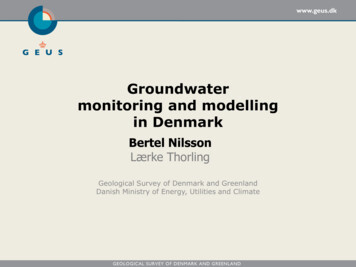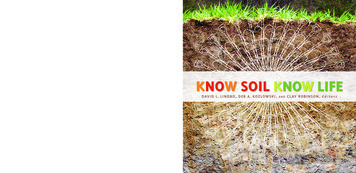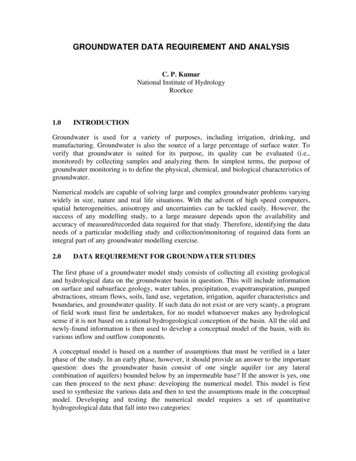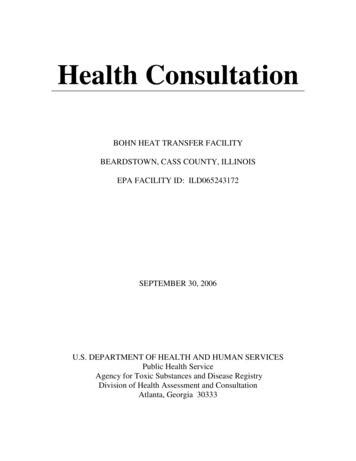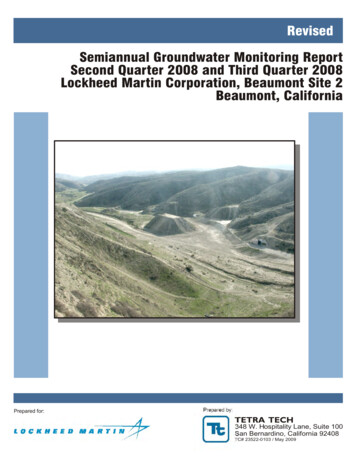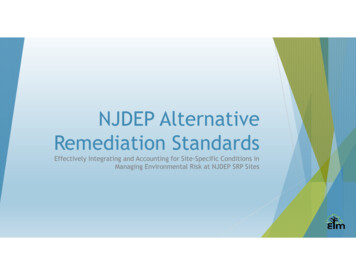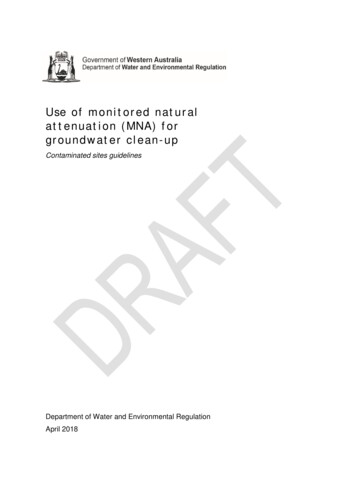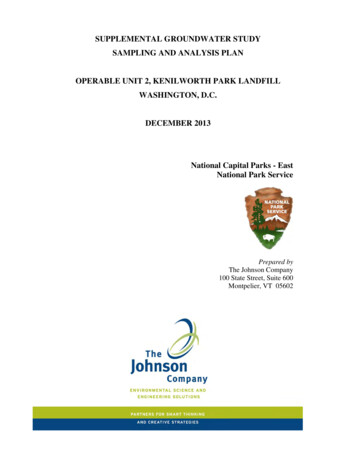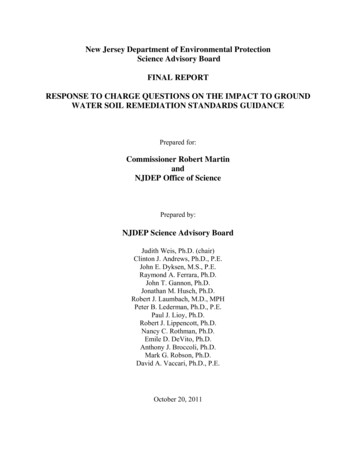
Transcription
New Jersey Department of Environmental ProtectionScience Advisory BoardFINAL REPORTRESPONSE TO CHARGE QUESTIONS ON THE IMPACT TO GROUNDWATER SOIL REMEDIATION STANDARDS GUIDANCEPrepared for:Commissioner Robert MartinandNJDEP Office of SciencePrepared by:NJDEP Science Advisory BoardJudith Weis, Ph.D. (chair)Clinton J. Andrews, Ph.D., P.E.John E. Dyksen, M.S., P.E.Raymond A. Ferrara, Ph.D.John T. Gannon, Ph.D.Jonathan M. Husch, Ph.D.Robert J. Laumbach, M.D., MPHPeter B. Lederman, Ph.D., P.E.Paul J. Lioy, Ph.D.Robert J. Lippencott, Ph.D.Nancy C. Rothman, Ph.D.Emile D. DeVito, Ph.D.Anthony J. Broccoli, Ph.D.Mark G. Robson, Ph.D.David A. Vaccari, Ph.D., P.E.October 20, 2011
TABLE OF CONTENTSIGWSRS REVIEW GROUP MEMBERSNOTICEEXECUTIVE SUMMARYABBREVIATIONS, ACRONYMS AND DEFINITONSSection1.0TitleINTRODUCTIONPage No.12.0SUMMARY OF FINDINGS43.0OVERVIEW OF IGWSRS GUIDANCE DOCUMENTS64.0DISCUSSION4.1 Response to Primary Charge Question4.2 Additional Charge Questions4.2.1 FAQ - Sites Undergoing Remedial Action forGround Water Contamination4.2.2 FAQ - Appendix A - Use of SESOIL to determinecompliance4.3 Specific Technical Issues4.3.1 Equilibrium Partition Assumptions4.3.2 Average and Mass4.3.3 Contingent Analyses and Sample Holding Time4.3.4 Validation/Calibration4.3.5 Alternative Back-Calculation Criteria4.3.6 Saturated Zone4.3.7 Spreadsheet Calculators4.3.8 ONS AND RECOMMENDATIONS196.0REFERENCES22LIST OF ATTACHMENTSAttachment1TitleCharge Questions
New Jersey Department of Environmental ProtectionScience Advisory BoardFINAL REPORTRESPONSE TO CHARGE QUESTIONS ON THE IMPACT TO GROUND WATERSOIL REMEDIATION STANDARDS GUIDANCEOctober 20, 2011SAB IGWSRS REVIEW GROUP MEMBERSDr. Robert J. Lippencott, ChairDr. John GannonDr. Peter B. LedermanDr. Nancy C. RothmanNOTICEThis report has been written as part of the activities of the Department of EnvironmentalProtection’s (NJDEP’s) Science Advisory Board, a public advisory committee providingextramural scientific information and advice to the Commissioner and other officials of theNJDEP. The Board is structured to provide balanced, expert assessment of scientific mattersrelated to problems facing the Department. This report has not been reviewed for approval by theDepartment and, hence, the contents of this report do not necessarily represent the views andpolicies of the NJDEP, nor of other agencies in the Executive Branch of the State government,nor does the mention of trade names or commercial products constitute a recommendation foruse. Reports of the NJDEP’s Science Advisory Board are posted on the NJDEP Web site at:http://www.state.nj.us/dep/sab/EXECUTIVE SUMMARYThe Science Advisory Board (SAB) was asked to perform a peer review of the site-specificImpact to Ground Water Soil Remediation Standards (IGWSRS) Guidance framework todetermine whether “associated assumptions and methodology reflect accurate andcomprehensive information to guide the Licensed Site Remediation Professional (LSRP) in theevaluation of potential impacts associated with the impact to ground water pathway”.Specifically, NJDEP Site Remediation Program (SRP) staff asked that the IGWSRS frameworkbe evaluated for usability and scientific validity. The review and report was completed by theSAB IGWSRS Review Group. A report was initially prepared by the SAB IGWSRS ReviewGroup and sent to the SAB for deliberation and comment, and then to the SRP for review andcomment. The SAB approved this final report, which addresses review comments provided bythe SAB members and SRP staff, based on the recommendations from the SAB IGWSRSReview Group.iFinal SAB IGWSRS Review Report 102011
The purpose of this report is to provide technical peer review comments and recommendationsthat are intended for use by the NJDEP staff and interested party stakeholders with a high degreeof technical background regarding the NJDEP IGWSRS Guidance.The SAB IGWSRS Review Group reviewed the IGWSRS Guidance and framework, supportingdocumentation provided by NJDEP, as well as several other references including the UnitedStates Environmental Protection Agency soil screening levels guidance, NJDEP’s IGWSRSbasis and background documentation, related NJDEP statutes and regulations, and scientificliterature. The IGWSRS Guidance was found to provide a more sophisticated method fordetermining numerical IGWSRS than previous standards and provides options to adopt defaultvalues or develop site-specific IGWSRS. The fundamental concept of the IGWSRS Guidanceframework (from simple/conservative to complex/refined) is technically appropriate, and itallows some flexibility for site-specific application. However, for a number of fairly commoncontaminants, the IGWSRS represent much lower values for remediation standards than thecriteria formerly used in New Jersey prior to 2008. The IGWSRS default values, and optionalsite-specific values generated by the user, appear to be overly conservative for a number ofcontaminants from a scientific perspective. In addition, risk management options (similar tothose used for other soil remediation standards to control potential exposure risks) are virtuallyabsent. The framework was found to be inflexible in several ways and complicated to follow.Using the framework to develop site-specific IGWSRS can be time consuming and may increaseinvestigation and remediation costs with no apparent value added for protection of human healthand the environment.The issues of conservative assumptions, and the degree to which exposure assumptions arerealistic or reasonable as required by New Jersey statutes, represented challenging, albeitnecessary, aspects of this review. A comprehensive evaluation of these issues is understood to bebeyond the scope of the charge question. However, a meticulous effort was made to providecomments and recommendations to the extent practicable to address issues of conservative,realistic and reasonable assumptions in the IGWSRS Guidance.The report includes many recommendations to improve the overall organization and usability ofthe IGWSRS framework. Specific suggestions for allowing the user flexibility in generatingsite-specific IGWSRS criteria are provided, which should help stream-line and improve theaccuracy of the process for LSRP use. Some of the more important recommendations include: Cross-Bureau Coordinationo In developing the IGWSRS, it is important to consider concerns within the agency thatare currently not part of the IGWSRS Guidance, such as the nexus with the saturatedzone, SRP Guidance, laboratory regulations, etc. Simplify the Processo While additional flexibility is recommended, the entire IGWSRS process should besimplified for the NJDEP and other stakeholders.iiFinal SAB IGWSRS Review Report 102011
Risk Managemento The current IGWSRS methodology is heavily dependent on a risk calculation thatassumes a future exposure (via drinking water) and does not incorporate risk managementdecisions that could modify the calculated IGWSRS to reflect actual and/or reasonablepotential site-specific exposure scenarios.o Provide for the use of “Risk Management Decisions-making”, e.g., consideration ofinstitutional and engineering controls.o Allow for greater use of site-specific data and apply conservative assumptions aboutpotential future impacts only when warranted (e.g., new or recent discharges). Organizationo Re-organize the guidance into one document and present more streamlined version of theprocess with details in appendices to make it more decision-based and user-friendly.o Add a decision-based flow chart or navigation scheme to guide users through the process.Additional important recommendations are provided in the Conclusions and Recommendations(Section 5) of this report.iiiFinal SAB IGWSRS Review Report 102011
ABBREVIATIONS, ACRONYMS AND DEFINITIONSAOC - Area of ConcernAT123D - Ground water fate and transport model.B&B - NJDEP Soil Remediation Standards Basis and Background documents (2004 and 2007).CEA - Ground Water Classification Exception AreaCERCLA - Comprehensive Environmental Response, Compensation, and Liability ActContingent Samples/Analyses – additional sample collection and/or chemical analyses andassociated extraction procedures that are required based on initial sample analyticalresults and that are made necessary by the IGWSRS Guidance.DAF - Dilution Attenuation FactorEP - Equilibrium Partition equationFAQ - Frequently Asked QuestionsFoc – fraction of organic carbonIGWSCC - Impact to Ground Water Soil Cleanup Criteria (1999)IGWSRS - Impact to Ground Water Soil Remediation StandardsIGWSRS - Impact to Ground Water Soil Screening LevelsIGWSRG - Impact to Ground Water Soil Remediation Goals; performance-based narrative ornumerical remediation goal generally for sites that are undergoing active or passiveground water remediation (i.e., impact to ground water is documented as a former orcurrent condition as opposed to a future potential risk based on site ground water data).Kd - soil-water partition coefficientKoc - organic carbon partition coefficientLSRP - Licensed Site Remediation ProfessionalNJAC - New Jersey Administrative CodeNJSA - New Jersey Statutory AuthorityPQL – Practical Quantitation LimitQA/QC - Quality Assurance/Quality ControlRCRA - Resource Conservation and Recovery ActSAB - NJ Science Advisory BoardSCC - Soil Cleanup CriteriaSESOIL - Vadose zone soil leaching modelSPLP - Synthetic Precipitation Leachate ProcedureSRG - Soil Remediation GoalSRP - NJDEP Site Remediation ProgramSRRA - Site Remediation Reform ActSSL - Soil Screening LevelSW-846 - USEPA solid waste program technical methodsTRSR - Technical Regulations for Site Remediation (NJAC 7:26E)USEPA - United States Environmental Protection AgencyVOC - Volatile Organic CompoundsZHE - Zero Headspace ExtractionivFinal SAB IGWSRS Review Report 102011
New Jersey Department of Environmental ProtectionScience Advisory BoardFINAL REPORTRESPONSE TO CHARGE QUESTIONS ON THE IMPACT TO GROUND WATERSOIL REMEDIATION STANDARDS GUIDANCEOctober 20, 20111.0INTRODUCTIONThe SAB was charged with review of the NJDEP’s Impact to Ground Water Soil RemediationStandards Guidance (IGWSRS Guidance), which was issued and became effective in 2008 andearly 2009.The NJDEP requires the use of the IGWSRS Guidance for investigation and remediation of sitessubject to compliance under the NJDEP’s Site Remediation Program (SRP). There are anestimated 20,000 cases in the SRP, virtually all of which require implementation of the IGWSRSGuidance.The NJDEP adopted Remediation Standards rules in 2008 (NJAC 7:26D; amended 2009) whichprovide soil remediation standards (SRS) for direct contact exposure scenarios. The rule doesnot establish minimum standards for the IGW pathway, but requires these standards bedeveloped on a site-by-site basis, pursuant to the Department’s authority under NJAC 7:26D 1.1(b) and NJSA 58:10B-12a, using the IGWSRS Guidance posted on the NJDEP website. TheIGWSRS differs from the direct contact SRS in that it is designed to protect ground water qualityfrom leaching of contaminants from the overlying soil. Therefore, site conditions can meet thedirect contact SRS, but fail to meet the IGWSRS. The 2008 Remediation Standards andIGWSRS Guidance supersede the former remediation criteria (i.e., Impact to Ground Water SoilCleanup Criteria [IGWSCC]) that had previously been in place for over 10 years.The SAB was asked to provide a peer review of the framework and inherent assumptions andmethodology of the IGWSRS Guidance for general scientific validity, completeness, accuracyand usability by New Jersey’s Licensed Site Remediation Professionals (LSRP). The SAB wasalso asked to address a specific issue involving determination of IGWSRS regardingcontaminated sites undergoing remedial action, which is not addressed in the guidance.The charge questions also referred to related issues including New Jersey’s statutoryrequirements, criticism by the regulated community regarding IGWSRS values being overlyconservative, and a note indicating that there is an historical misunderstanding andmisapplication of the impact to ground water pathway evaluation.The charge questions as originally proposed to the SAB are provided in Attachment 1.1Final SAB IGWSRS Review Report 102011
The purpose of this report is to provide technical peer review comments and recommendationsthat are intended for use by the NJDEP staff and interested party stakeholders with a high degreeof technical background regarding the NJDEP IGWSRS Guidance.The review and report was completed by the SAB IGWSRS Review Group. A report wasinitially prepared by the SAB IGWSRS Review Group and sent to the SAB for deliberation andcomment, and then to the SRP for review and comment. Based on the recommendations from theSAB IGWSRS Review Group, the SAB approved this final report, which addresses reviewcomments provided by the SAB members and SRP staff.The IGWSRS Review Group performed a review of the IGWSRS framework and guidancedocuments provided on the NJDEP website. In addition, several other references were consultedfor this review including the USEPA soil screening levels guidance, NJDEP’s IGWSRS basisand background document, related NJDEP statutes and regulations, and scientific literature (seeReferences). As part of this review of the IGWSRS Guidance, SAB members met with NJDEPSite Remediation Program (SRP) staff scientists in December 2010 and again in January 2011todiscuss the associated technical issues. The working sessions facilitated a more focuseddiscussion of the details and underlying concepts and assumptions of the methodology, formulasand selection of default values in the equations and models.The SAB evaluated the IGWSRS Guidance based on the following general categories that wereused to guide the pletenessAccuracyThe issues of conservative assumptions, redundancy and the degree to which exposureassumptions are realistic or reasonable required by New Jersey statutes, represented challenging,albeit necessary, aspects of this review. Developing IGWSSL and SRS requires makingassumptions that are both numerical and conceptual (i.e., non-numerical), and that are expectedto include some reasonable level of conservatism to provide a margin of safety. The NJDEP wasinstructed by the Legislature in S-1070 amendments (1993) to avoid using redundantconservative assumptions. According to the current SRRA (2009 amendments to Section 35 ofP.L.1993, c.139 [NJAS 58:10B-12]), the NJDEP is to develop site-specific remediation standardsbased upon reasonable assumptions of exposure scenarios, avoiding the use of redundantconservative assumptions by the use of parameters that provide an adequate margin of safety,and which avoid the use of unrealistic conservative exposure parameters. A comprehensiveevaluation of these issues is understood to be beyond the scope of the charge question.Notwithstanding, a meticulous effort was made to provide comments and recommendations toaddress these aspects of assumptions in the IGWSRS Guidance, which was required to completethis review. It should be noted that IGWSSL calculated from conservative default literaturevalues and assumptions are generally considered to be less accurate than those developed usingsite-specific data. However, less accurate does not necessarily mean less stringent, as the default2Final SAB IGWSRS Review Report 102011
SSLs are based on multiple conservative assumptions and values to account for the uncertaintyof limited site-specific data.3Final SAB IGWSRS Review Report 102011
2.0SUMMARY OF FINDINGSThe IGWSRS Guidance provides a good degree of relatively accurate guidance and helpfulspreadsheet calculators. Some of the assumptions and aspects of the methodology are toolimiting and prescriptive. Also, some of the current available scientific information and existingmethods should be added to the guidance to provide the kind of flexibility needed for use by anLSRP. A brief summary of findings and recommendations is included below; more detailedinformation is provided in following sections.o Overview of Major Concepts and Considerations in IGWSRSo Limited to Unsaturated Zone.o SRS back-calculated from Ground Water Quality Standards (GWQS).o Intended to protect from future ground water impacts (i.e., predictive).o Organizationo Organization is not user-friendly, due in part to lack of a decision-based procedure,absence of a decision tree or flow chart, and hidden, unclear or unaddressedramifications to various associated rules and guidance.o Process seems overly complex for many sites that would otherwise be considered as alow or minimal risk.o Modifications to guidance through FAQs may create uncertainty (e.g., numerousunscheduled changes to guidance without a phase-in period for existing projects) andis potentially inconsistent with guidance development requirements under SRRA.o Redundant information present throughout the guidance could be eliminated throughre-organization of the document.o Transparencyo Not transparent in some important areas including technical basis, source references,spreadsheet calculation formulas.o References not included (e.g., literature values in Chemical Properties table, Basisand Background documentation [current form is incomplete and not readilyavailable], formulas in calculation spreadsheets).o Flexibilityo Relatively inflexible and prescriptive.o Incorporate more technically applicable tools (e.g., greater use of site-specific data,flexibility in sample analytical methods (e.g., freezing of soil samples for volatileand/or non-volatile organics analysis to increase hold times).o Allow SPLP for VOCs, bench test methods (e.g., column studies).o Provide for risk management options to allow for site-specific exposure scenarioassumptions that are realistic and reasonable.o Include risk assessment options, which are allowed under NJSA 58:10B-12.35.f.(Notwithstanding any limit or potential conflict in New Jersey’s statutes, riskassessment is a technically viable approach to establishing remediation standards andshould be available for evaluation of the IGW pathway.)4Final SAB IGWSRS Review Report 102011
o Consider options for setting preliminary IGW soil remediation goals (IGWSRG), e.g.,for sites with confirmed impacts to ground water.o Expand performance-based, observed conditions approach using site-specificmonitoring data for IGW pathway assessment and model validation/calibration.o Completenesso Incomplete; does not include guidance on some important issues (such as those listedbelow).o Should include guidance for saturated zone soils since the behavior of contaminantsin unsaturated and saturated subsurface soils may be closely related.o Current guidance does not meet SRRA requirements for use by the LSRP, whichrequires interested party review.o Update to expand options including: Using available analytical methods for site-specific Kd for all contaminants(SPLP for VOCs, bench/batch tests, column studies, etc.). IGW site remediation goals (as opposed to “standards” to provide a performancestandard approach, e.g., for sites with active remediation or monitoring). Allow for the use of site-specific risk assessment. Incorporate risk management decision-making analogous to current methods foraddressing contaminants in soil above direct contact soil remediation standards(e.g., institutional and/or engineering controls to manage potential exposure).o Coordinate with remediation permits and associated institutional and engineeringcontrols (soil and ground water).o Accuracyo Some IGWSRS (especially for VOCs) suffer from cumulative conservativeassumptions (conceptual and numerical).o Conservative assumptions are reasonable where data are absent or limited, but overlyconservative and unreasonable where site-specific data are available.o Include options to use alternative values with, or in place of, default conservativevalues from peer-reviewed literature or databases.o Expand use of site-specific soil and/or ground water data to generate more realisticIGWSRS when the data are available.o Incorporate methods to calibrate/validate predictive calculations and models.o Include options for IGWSRS or SRG where site conditions warrant more advancedevaluation (e.g., changes to GWQS, sites with long-term CEA, or where Class IIAGWQS do not apply, etc.).5Final SAB IGWSRS Review Report 102011
3.0OVERVIEW OF IGWSRS GUIDANCE DOCUMENTSThe IGWSRS Guidance (published on the NJDEP Webpage) is comprised of several documents,including an introductory document (recently deleted and changed to webpage introduction) andseveral technical documents focused on various site conditions and types of hazardoussubstances. Associated documents include several spreadsheet forms that function as interactivecalculators for data input by the user. In addition, the IGWSRS guidance prescribes the use ofspecific modeling software (SESOIL and AT123D) with limitations. The model software mustbe purchased, and requires specialized training and experience. The IGWSRS Guidance is alsomodified through responses to frequently asked questions (FAQs) periodically posted on theNJDEP website.The overall IGWSRS Guidance concept includes conservatively low default IGW soil screeninglevels that may be adopted as site-specific soil remediation standards (default IGWSRS).Depending on the contaminant, as well as on the site conditions, site-specific IGWSRS may bedeveloped using other models and methodologies. The various additional documents,spreadsheets and models provide for input of site-specific data to allow further evaluation ofcontaminants that are above the default IGWSRS values. This general concept of having asimple/generic/more conservative approach then allowing the ability to develop a complex/sitespecific/more refined approach to evaluation is appropriate. However, the IGWSRS Guidancedocuments and spreadsheets contain several restrictions and limitations that are not all clearlysupported with defensible scientific basis and background information (i.e., not provided,incomplete or questionable).6Final SAB IGWSRS Review Report 102011
4.0DISCUSSION4.1 Response to Primary Charge QuestionGeneralGuidance for evaluating the IGW pathway and for developing site-specific IGWSRS isnecessary. The USEPA SSL guidance is useful, but is overly simplistic and provides littleinformation regarding more advanced evaluation necessary for establishing remediationstandards. The USEPA methods for developing remediation standards for concerns identifiedthrough the IGWSSL process rely mostly on site-specific risk assessment procedures generallydesigned for relatively complex sites (e.g., subject to the CERCLA/NPL [Superfund], RCRA,NCP, etc.). Many sites subject to the NJDEP SRP requirements likely benefit from adapting thesimpler USEPA SSL methods by addressing the IGW pathway through the process ofelimination. However, a number of NJDEP SRP sites require a level of moderately complexevaluation that is somewhere between the SSL and a more formal risk assessment. The NJDEPIGWSRS Guidance provides methods and assumptions for addressing the IGW pathway thatextend beyond the USEPA SSL process, but does not include risk management options or theoption to use risk assessment.FrameworkThe fundamental concept of the IGWSRS Guidance framework (from simple/conservative tocomplex/refined) is technically appropriate, and it allows flexibility for site-specific application.However, the technical basis and background information is not generally available and keyreferences are missing or incomplete. For example, references are not included for the valueslisted in the Contaminant Properties Table on the IGWSRS website.Organizationally, the framework is set out in several documents that are difficult to navigate andsubject to change. For a first time viewer, the IGWSRS Guidance documents appear as apatchwork that is not user-friendly. Examples include, missing documents on the IGWSRSwebsite, documents not presented in the proper order to facilitate decision-based navigation, andexternal updates via FAQs. The IGWSRS Guidance documents should be reorganized andcombined to facilitate framework stability and method continuity, and to enhance usability. Anyrevised document should be made easy to navigate and dates of revisions documented. Adecision-based flow chart should also be added to assist the user in navigating the process.Methodology and AssumptionsPortions of the IGWSRS Guidance use the USEPA SSL guidance as a general basis for methodsand assumptions. While many of the IGWSRS methods and assumptions are technicallyappropriate, not all are consistent with or included in the USEPA SSL guidance. Some of theIGWSRS assumptions violate the USEPA SSL model, are inappropriate when site-specific dataare available, and when taken together, may be contrary to state law that limits the use ofredundant or unrealistic conservative assumptions for the development of remediation standards.Note that the USEPA SSL guidance makes very clear that many simplifying conservativeassumptions are used and that the resulting SSLs are not intended to be remediation standards,but are screening values to aid in refining the list of contaminants of concern for further review.Some of the method assumptions that contribute to overly conservative SSL and SRS values arelisted and discussed below.7Final SAB IGWSRS Review Report 102011
USEPA SSL method assumptions that contribute to conservative SSLs and SRS:o Residential Land Use (“SSLs developed in accordance with this guidance are based onfuture residential land use assumptions and related exposure scenarios. Using thisguidance for sites where residential land use assumptions do not apply could result inoverly conservative screening levels; however, EPA recognizes that some partiesresponsible for sites with non-residential land use might still find benefit in using theSSLs as a tool to conduct a conservative initial screening.” [USEPA, 1996; EmphasisAdded]).o Infinite source of contaminant mass (USEPA’s SSL guidance notes that assuming aninfinite mass can violate mass balance considerations especially for small sources).o Potable use of shallow ground water near source investigation area.o Adsorption of organic compounds strictly limited to soil organic carbon.o Instantaneous and linear equilibrium soil/water partitioning.NJDEP IGWSSL assumptions in addition to USEPA assumptions:o Used as predictive model to protect against future potential impacts to ground waterregardless of age of the discharge.o Method and assumptions applied regardless of existing site-specific ground water quality.o Single point compliance (i.e., precludes use of statistical analyses [mean, UCL]).o Potable use of shallow ground water in source/investigation area.o All SSLs and SRS are back-calculated from Class IIA GWQS only and do not providefor areas where they may not apply. The IGWSRS Guidance does not describe methodsfor developing IGWSRS using site-specific ground water quality criteria other than ClassIIA GWQS.o Limitations on use of available sample analytical technology and methods (e.g., SPLP forVOCs , extension of holding times for contingent analysis. Note that the NJDEP SRPrationale for omitting use of SPLP for VOCs is flawed due to incorrect assumptionsregarding field sampling procedures.)o Infinite source of contaminant mass with no allowance for mass-balance correction wherewarranted.o Requires minimum of 3 samples per AOC for SPLP analysis, without flexibility forsimilar site-wide soil conditions that encompass multiple AOCs.o Requires use and submission of NJDEP-provided spreadsheet calculators where fieldsand values are locked and cannot be changed by the data user (even when spreadsheetinformation is inaccurate compared to site data or conditions or results are illegible).o No correction allowed for surface impermeable cap in ground water mixing zone dilutionattenuation factor (DAF) calculation.The IGWSRS Guidance, and supporting documents and information, includes discussion andrationale for many of the methods and assumptions. However, some of the rationale andrequirements are not supported by a technical or scientific discussion, or are explained byreference to state laws and regulation and/or policies not in any laws or regulations.In addition, there are implicit conceptual assumptions that add to the conservatism of theIGWSRS Guidance. These qualitative conservative assumptions include:8Final SAB IGWSRS Review Report 102011
assuming column or batch tests are “experimental” (i.e., unreliable);assuming that site-specific soil and ground water data are not related;taking a very limited view of historical and existing site-specific data usability; andapplying the same conservative assumptions about of low-mobility substances to VOCs (e.g.,assuming VOCs will migrate to the ground water after some long-term period into the future,when IGWSRS Guidance calculations, models and/or site-specific data demonstrateotherwise).These are examples of assumptions inherent in the IGWSRS Guidance that are non-numeric andnot easily accounted for when addressing the issue of redundant conservative assumptions. Itshould be noted that concern about future potential migration to ground water from soils may bevalid for new discharges, but soil contamination at many remediation sites represents a legacyfrom past discharges that is now under metastable equilibrium conditions. The precautionaryassumption in the IGWSRS that legacy soil contamination will mobilize to cause a future groundwater impact is not warranted, and is inappropriate and overly conservative for many of theseolder sites. Thus, while site-specific data that may be used to confirm these legacy conditionsare often available, they are not allowed to be considered under the current IGWSRS Guidance.A fundame
The NJDEP requires the use of the IGWSRS Guidance for investigation and remediation of sites subject to compliance under the NJDEP's Site Remediation Program (SRP). There are an estimated 20,000 cases in the SRP, virtually all of which require implementation of the IGWSRS Guidance.
